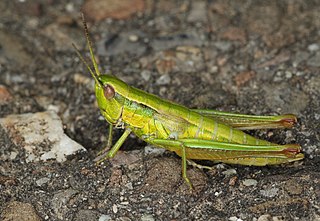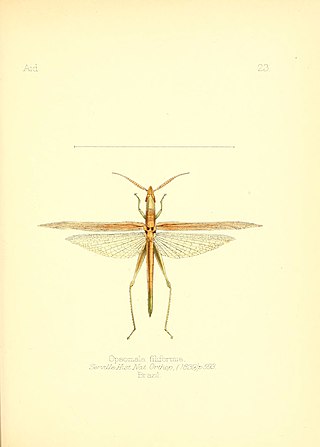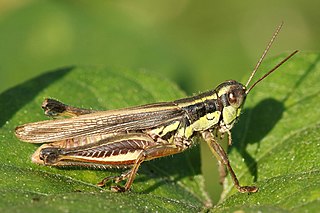
Bandwings, or band-winged grasshoppers, are the subfamily Oedipodinae of grasshoppers classified under the family Acrididae. They have a worldwide distribution and were originally elevated to full family status as the Oedipodidae. Many species primarily inhabit xeric weedy fields, and some are considered to be important locusts:

The Melanoplinae are a subfamily of grasshoppers in the family Acrididae. They are distributed across the Holarctic and Neotropical realms. They are one of the two largest subfamilies in the Acrididae. As of 2001 the Melanoplinae contained over 800 species in over 100 genera, with more species being described continuously.

Cryptotympanini is a tribe of cicadas in the family Cicadidae. They are found in the Nearctic, Palearctic, Indomalaya, Oceania, and Afrotropics.

Gomphocerinae, sometimes called "slant-faced grasshoppers", are a subfamily of grasshoppers found on every continent but Antarctica and Australia.

Issidae is a family of planthoppers described by Spinola in 1839, belonging to the order Hemiptera, suborder Auchenorrhyncha superfamily Fulgoroidea.

The Blissidae are a family in the Hemiptera, comprising nearly 50 genera and 400 species. The group has often been treated as a subfamily of the Lygaeidae but was resurrected as a full family by Thomas Henry (1997).

Romaleinae is a subfamily of lubber grasshoppers in the family Romaleidae, found in North and South America. More than 60 genera and 260 described species are placed in the Romaleinae.
Abila is a genus of lubber grasshoppers in the family Acrididae. There are at least four described species in Abila. They occur in South America.

Nothodelphax is a genus of delphacid planthoppers in the family Delphacidae. There are more than 20 described species in Nothodelphax.

Rhammatocerus is a genus of grasshoppers in the subfamily Gomphocerinae and the tribe Scyllinini. There are about 16 described species in Rhammatocerus, including R. schistocercoides, the "Mato Grosso locust".

Oncopeltus is a genus of seed bugs in the family Lygaeidae, which has at least 40 described species.

Leptysminae is a subfamily of spur-throat toothpick grasshoppers in the family Acrididae. There are at least 20 genera in Leptysminae, found in North, Central, and South America.

Clavigralla is a genus of true bugs belonging to the family Coreidae.

Dichroplus is a genus of spur-throated grasshoppers in the family Acrididae. There are more than 20 described species in Dichroplus, found in North, Central, and South America.

Ronderosia is a genus of spur-throated grasshoppers in the family Acrididae. There are about 10 described species in Ronderosia, found in South America.

Urnisa is a genus of short-horned grasshoppers in the family Acrididae. There are at least three described species in Urnisa, found in Australia.

Stenopola puncticeps is a species of spur-throat toothpick grasshopper in the family Acrididae. It is found in Central and South America.

Scotussa is a genus of spur-throated grasshoppers in the family Acrididae. There are about seven described species in Scotussa, found in South America.

The Ommatolampidinae are a subfamily of grasshoppers in the family Acrididae, found in central and South America, and based on the type genus Ommatolampis. Derived from the "Ommatolampides" used by Brunner von Wattenwyl in 1893, the first use of the name in its current form was by Rodríguez et al. in 2013; this taxon appears to be paraphyletic.



















